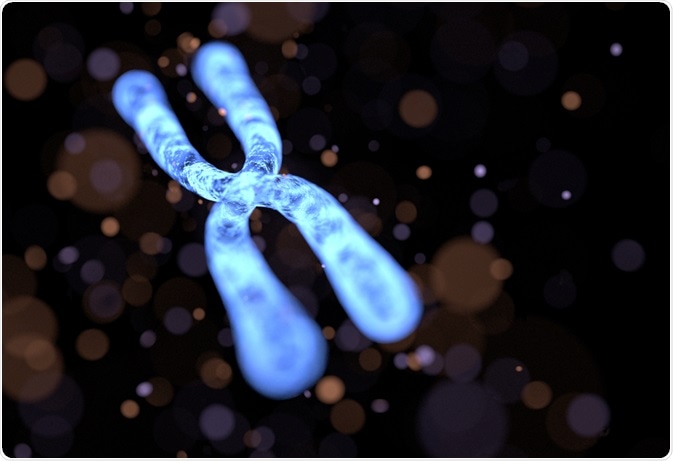
Chromosome 5 Related Diseases
Chromosome 5 comprises 194 million base pairs, that make-up 844 confirmed genes (6% of all the genetic material in our genome). Despite being one of the largest human chromosomes, chromosome 5 has one of the lowest gene densities, owing to a significant amount of non-coding DNA between genes.
Of the 844 genes on chromosome 5, mutations in 73 genes have been implicated in human disease. Numerous diseases are additionally thought to be related to chromosome 5 but have not yet been mapped to specific genes. This article describes some of the diseases that arise due to mutations within genes on chromosome 5.
 Graphic Compressor | Shutterstock
Graphic Compressor | ShutterstockSpinal Muscular Atrophy (SMA)
SMA is an autosomal recessive inherited neuromuscular and degenerative disease in which the motor-neurons of the spinal cord and brainstem degenerate, causing progressive muscular weakness and wasting.
Mutations in the SMN1 gene found on 5q13 have been linked to SMA. SMN1 (a telemoric copy) encodes a critical protein called ‘survival of motor neuron’ protein, which, as the name implies, is important in the development and survival of motor neurons. The severity of the condition depends on how functional SMN2 is (the centromeric copy). SMN2 is able to, in part, make up some of the protein, although this is not a proportional relationship and other factors can influence severity.
Cri du Chat syndrome
Cri du chat (‘cat cry’) syndrome is also known as 5p-syndrome is caused by a deletion on the short arm of chromosome 5 (5p). The most common symptoms are a ‘cat-like cry’, a high-pitched voice, severe early intellectual disability, low-set backwardly rotated ears and prominent eye-folds.
The magnitude of the 5p- deletion correlates with the severity of intellectual disability and developmental delay. Within 5p is a key gene, CTNND2, which is associated with intellectual disability. Other genes within this locus are not yet fully characterized.
5q-syndrome
A deletion on the long arm of chromosome 5 (5q) results in a bone marrow disorder, myelodysplastic syndrome, where blood cells do not mature and fail to develop normally. Individuals with 5q- syndrome suffer from anemia (reduced red blood cells), abnormalities in platelet production (impaired clotting) as well as an increased risk of acute myeloid leukemia (AML).
In 5q-syndrome, approximately 1.5 million base pairs of DNA are deleted, which contains 40 genes. Importantly, the loss of RPS14 leads to red blood cell abnormalities, and the loss of MIR145 causes platelet dysfunction.
5q31.3 microdeletion syndrome
5q31.3 microdeletion syndrome is a complex disorder characterized by weak muscle tone, swallowing and breathing difficulties, severe development of speech and motor skills. In addition, there are distinct structural features such as a narrow forehead, spaced eyes, open mouth with a tented upper lip as well as a lack of facial expression. These can be attributed to muscle tone weakness (hypotonia). Furthermore, seizures (epilepsy) are also common.
As the name suggests, this condition is caused by a small deletion on the long arm (q) of chromosome 5 (at point q13.1). The deletion can cause the loss of several thousand DNA base pairs. In this region, there are 3 key genes, with the loss of the gene PURA, being the most significant. PURA is involved in the development of the brain by allowing neurons to grow and divide as well as being involved in myelination (protecting nerves).
Other conditions associated with chromosome 5:
- Cancers
- Acute Myeloid Leukaemia – due to deletions on 5q (similar to 5q-)
- PDGFRB-Associated Chronic Eosinophilic Leukaemia – translocation in chromosome 5
- Increased susceptibility to Asthma – 5q31-33 contains key genes involved in immunity such as those that govern IgE levels leading to bronchial hyperresponsiveness (BHR).
Sources
Further Reading
Last Updated: Feb 15, 2019























.png)









No hay comentarios:
Publicar un comentario